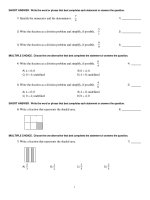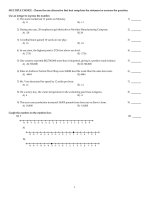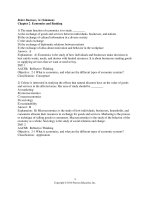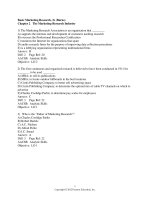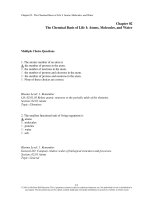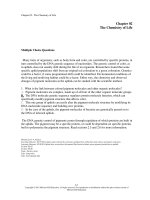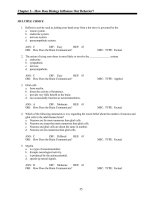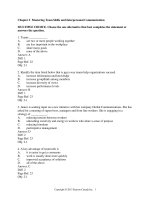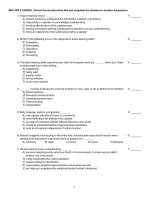CFIN 3 3rd edition besley test bank
Bạn đang xem bản rút gọn của tài liệu. Xem và tải ngay bản đầy đủ của tài liệu tại đây (527.71 KB, 21 trang )
Chapter 2
Analysis of Financial Statements
10
CHAPTER 2—ANALYSIS OF FINANCIAL STATEMENTS
TRUE/FALSE
1. The income statement measures the flow of funds into (i.e. revenue) and out of (i.e. expenses) the
firm over a certain time period. It is always based on accounting data.
ANS: T
DIF: Easy
TOP: Income statement
2. The balance sheet is a financial statement measuring the flow of funds into and out of various
accounts over time while the income statement measures the progress of the firm at a point in
time.
ANS: F
DIF: Easy
TOP: Financial statements
3. An increase in an asset account is a source of cash, whereas an increase in a liability account is a
use of cash.
ANS: F
DIF: Easy
TOP: Sources and uses of cash
4. Depreciation, as shown on the income statement, is regarded as a use of cash because it is an
expense.
ANS: F
DIF: Easy
TOP: Sources and uses of cash
5. When a firm pays off a loan using cash, the source of funds is the decrease in the asset account,
cash, while the use of funds involves a decrease in a liability account, debt.
ANS: T
DIF: Easy
TOP: Sources and uses
6. Non-cash assets are expected to produce cash over time but the amount of cash they eventually
produce could be higher or lower than the values at which the assets are carried on the books.
ANS: T
DIF: Easy
TOP: Non-cash assets
7. Taxes, payment patterns, and reporting considerations, as well as credit sales and non-cash costs,
are reasons why operating cash flows can differ from accounting profits.
ANS: T
DIF: Easy
TOP: Operating cash flows
8. Ratio analysis involves a comparison of the relationships between financial statement accounts so
as to analyze the financial position and strength of a firm.
ANS: T
DIF: Easy
TOP: Ratio analysis
9. The current ratio and inventory turnover ratio measure the liquidity of a firm. The current ratio
measures the relation of a firm's current assets to its current liabilities and the inventory turnover
ratio measures how rapidly a firm turns its inventory back into a "quick" asset or cash.
ANS: F
DIF: Easy
TOP: Liquidity ratios
10. If a firm has high current and quick ratios, this always is a good indication that a firm is managing
its liquidity position well.
ANS: F
DIF: Easy
TOP: Current ratio
© 2013 Cengage Learning. All rights reserved. May not be scanned, copied or duplicated, or posted to a publicly
accessible website, in whole or in part.
Chapter 2
Analysis of Financial Statements
11
11. A decline in the inventory turnover ratio suggests that the firm's liquidity position is improving.
ANS: F
DIF: Easy
TOP: Inventory turnover ratio
12. The degree to which the managers of a firm attempt to magnify the returns to owners' capital
through the use of financial leverage is captured in debt management ratios.
ANS: T
DIF: Easy
TOP: Debt management ratios
13. Profitability ratios show the combined effects of liquidity, asset management, and debt
management on operations.
ANS: T
DIF: Easy
TOP: Profitability ratios
14. Determining whether a firm's financial position is improving or deteriorating requires analysis of
more than one set of financial statements. Trend analysis is one method of measuring a firm's
performance over time.
ANS: T
DIF: Easy
TOP: Trend analysis
15. The information contained in the annual report is used by investors to form expectations about
future earnings and dividends.
ANS: T
DIF: Easy
TOP: Annual report
16. The balance sheet presents a summary of the firm’s revenues and expenses over an accounting
period.
ANS: F
DIF: Easy
TOP: Financial statements
17. On the balance sheet, total assets must equal total liabilities plus stockholders equity.
ANS: T
DIF: Easy
TOP: Balance sheet
18. One of the biggest noncash items on the income statement is depreciation which needs to be
subtracted from net income to determine cash flows for the firm.
ANS: F
DIF: Easy
TOP: Cash flows
19. A firm's net income reported on its income statement must equal the operating cash flows on the
statement of cash flows.
ANS: F
DIF: Easy
TOP: Accounting profit and cash flows
20. A statement reporting the impact of a firm’s operating, investing, and financing activities on cash
flows over an accounting is the statement of cash flows.
ANS: T
DIF: Easy
TOP: Statement of cash flows
21. When a firm conducts a seasoned equity offering, it increases an equity account which is an
example of a source of funds.
ANS: T
DIF: Easy
TOP: Sources and uses of cash
22. When a firm conducts a stock repurchase, it increases an equity account which is an example of a
source of funds.
ANS: F
DIF: Easy
TOP: Sources and uses of cash
© 2013 Cengage Learning. All rights reserved. May not be scanned, copied or duplicated, or posted to a publicly
accessible website, in whole or in part.
Chapter 2
Analysis of Financial Statements
12
23. A liquid asset is an asset that can be easily converted into cash without a significant loss of its
original value.
ANS: T
DIF: Easy
TOP: Liquidity ratios
24. Genzyme Corporation has seen its days sales outstanding (DSO) decline from 38 days last year to
22 days this implying that more of the firm’s suppliers are being paid on time.
ANS: F
DIF: Easy
TOP: Days sales outstanding (DSO)
25. Funds supplied by common stockholders mainly includes capital stock, paid-in capital, and
retained earnings, while total equity is comprised of common equity plus preferred stock.
ANS: T
DIF: Medium
TOP: Total equity
26. Retained earnings is the cash that has been generated by the firm through its operations which has
not been paid out to stockholders as dividends. Retained earnings are kept in cash or near cash
accounts and thus, these cash accounts, when added together, will always be equal to the total
retained earnings of the firm.
ANS: F
DIF: Medium
TOP: Retained earnings
27. The financial position of companies whose business is seasonal can be dramatically different
depending upon the time of year chosen to construct financial statements. This time sensitivity is
especially true with respect to the firm's balance sheet.
ANS: T
DIF: Medium
TOP: Balance sheet changes
28. In order to accurately estimate cash flow from operations, depreciation must be added back to net
income. The reason for this is that even though depreciation is deducted from revenue it is really
a non-cash charge.
ANS: T
DIF: Medium
TOP: Cash flows
29. In accounting, emphasis is placed on determining net income. In finance, the primary emphasis
also is on net income because that is what investors use to value the firm. However, a secondary
consideration is cash flow because that's what is used to run the business.
ANS: F
DIF: Medium
TOP: Cash flow and net income
30. Current cash flow from existing assets is highly relevant to the investor. However, the value of
the firm depends primarily upon its growth opportunities. As a result, profit projections from
those opportunities are the only relevant future flows with which investors are concerned.
ANS: F
DIF: Medium
TOP: Future cash flows
31. If the current ratio of Firm A is greater than the current ratio of Firm B, we cannot be sure that the
quick ratio of Firm A is greater than that of Firm B. However, if the quick ratio of Firm A
exceeds that of Firm B, we can be assured that Firm A's current ratio also exceeds B's current
ratio.
ANS: F
DIF: Medium
TOP: Liquidity ratios
32. The inventory turnover and current ratios are related. The combination of a high current ratio and
a low inventory turnover ratio relative to the industry norm might indicate that the firm is
maintaining too high an inventory level or that part of the inventory is obsolete or damaged.
ANS: T
DIF: Medium
TOP: Inventory turnover ratio
© 2013 Cengage Learning. All rights reserved. May not be scanned, copied or duplicated, or posted to a publicly
accessible website, in whole or in part.
Chapter 2
Analysis of Financial Statements
13
33. We can use the fixed asset turnover ratio to legitimately compare firms in different industries as
long as all the firms being compared are using the same proportion of fixed assets to total assets.
ANS: F
DIF: Medium
TOP: Fixed asset turnover
34. Suppose two firms with the same amount of assets pay the same interest rate on their debt and
earn the same rate of return on their assets, and that ROA is positive. However, one firm has a
higher debt ratio. Under these conditions, the firm with the higher debt ratio will also have a
higher rate of return on common equity.
ANS: T
DIF: Medium
TOP: ROA and ROE
35. Suppose a firm wants to maintain a specific TIE ratio. If the firm knows the level of its debt, the
interest rate it will pay on that debt and the applicable tax rate, the firm can then calculate the
earnings level required to maintain its target TIE ratio.
ANS: T
DIF: Medium
TOP: TIE ratio
36. The fixed charge coverage ratio recognizes that firms often lease equipment under contract and
thus, some firms must meet more than just their scheduled interest payments out of earnings.
Therefore, the fixed charge coverage is more inclusive than the TIE ratio.
ANS: T
DIF: Medium
TOP: Fixed charge coverage ratio
37. If sales decrease and financial leverage increases, we can say with certainty that the profit margin
on sales will decrease.
ANS: F
DIF: Medium
TOP: Profit margin and leverage
38. Selling new stock is an equity transaction; it does not affect any asset or liability account and
therefore, does not appear on the statement of cash flows.
ANS: F
DIF: Medium
TOP: Financing activities
MULTIPLE CHOICE
1. Other things held constant, which of the following will not affect the quick ratio? (Assume that
current assets equal current liabilities.)
a. Fixed assets are sold for cash.
b. Cash is used to purchase inventories.
c. Cash is used to pay off accounts payable.
d. Accounts receivable are collected.
e. Long-term debt is issued to payoff a short-term bank loan.
ANS: D
The quick ratio is calculated as follows:
𝐶𝑢𝑟𝑟𝑒𝑛𝑡 𝐴𝑠𝑠𝑒𝑡𝑠−𝐼𝑛𝑣𝑒𝑛𝑡𝑜𝑟𝑖𝑒𝑠
𝐶𝑢𝑟𝑟𝑒𝑛𝑡 𝐿𝑖𝑎𝑏𝑖𝑙𝑖𝑡𝑖𝑒𝑠
The only action that doesn't affect the quick ratio is statement d. While this action decreases
receivables (a current asset), it increases cash (also a current asset). The net effect is no change in
the quick ratio.
DIF: Easy
OBJ: TYPE: Conceptual
TOP: Quick ratio
© 2013 Cengage Learning. All rights reserved. May not be scanned, copied or duplicated, or posted to a publicly
accessible website, in whole or in part.
Chapter 2
Analysis of Financial Statements
14
2. Changes in balance sheet accounts are necessary for
a. A typical ratio analysis.
b. Pro forma balance sheet construction.
c. Statement of cash flows construction.
d. Profit and loss analysis.
e. Pro forma income statement construction.
ANS: C
DIF: Easy
TOP: Statement of cash flows
OBJ: TYPE: Conceptual
3. All of the following represent cash outflows to the firm except
a. Taxes.
b. Interest payments.
c. Dividends.
d. Purchase of plant and equipment.
e. Depreciation.
ANS: E
DIF: Easy
OBJ: TYPE: Conceptual
TOP: Cash flows
4. Other things held constant, if a firm holds cash balances in excess of their optimal level in a noninterest bearing account, this will tend to lower the firm's
a. Profit margin.
b. Total asset turnover.
c. Return on equity.
d. All of the above.
e. Answers b and c above.
ANS: E
DIF: Easy
TOP: Excessive cash balances
OBJ: TYPE: Conceptual
5. Other things held constant, which of the following will not affect the current ratio, assuming an
initial current ratio greater than 1.0?
a. Fixed assets are sold for cash.
b. Long-term debt is issued to pay off current liabilities.
c. Accounts receivable are collected.
d. Cash is used to pay off accounts payable.
e. A bank loan is obtained, and the proceeds are credited to the firm's checking account.
ANS: C
DIF: Easy
OBJ: TYPE: Conceptual
TOP: Current ratio
6. The annual report contains all of the following financial statements except
a. income statement.
b. statement of changes in long-term financing.
c. statement of cash flows.
d. balance sheet.
e. statement of retained earnings.
ANS: B
DIF: Easy
OBJ: TYPE: Conceptual
TOP: Annual report
© 2013 Cengage Learning. All rights reserved. May not be scanned, copied or duplicated, or posted to a publicly
accessible website, in whole or in part.
Chapter 2
Analysis of Financial Statements
15
7. Which of the following financial statements shows a firm’s financing activities (how funds were
generated) and investment activities (how funds were used) over a particular period of time?
a. balance sheet
b. income statement
c. statement of retained earnings
d. statement of cash flows
e. proxy statement
ANS: A
DIF: Easy
TOP: Financial statements
OBJ: TYPE: Conceptual
8. Which of the following statements shows the portion of the firm’s earnings that has been saved
rather than paid out as dividends?
a. balance sheet
b. income statement
c. statement of retained earnings
d. statement of cash flows
e. proxy statement
ANS: C
DIF: Easy
TOP: Financial statements
OBJ: TYPE: Conceptual
9. Which of the following financial statements includes information about a firm’s assets, equity,
and liabilities?
a. Income statement
b. Cash flow statement
c. Balance sheet
d. Statement of retained earnings
e. All of the above
ANS: C
DIF: Easy
TOP: Financial statements
OBJ: TYPE: Conceptual
10. When constructing a Statement of Cash Flows, which of the following actions would be
considered a source of funds?
a. increase in the cash account
b. decrease in accounts payable
c. increase in inventory
d. increase in long-term bonds
e. increase in fixed assets
ANS: B
DIF: Easy
TOP: Financial statements
OBJ: TYPE: Conceptual
11. Which of the following groups probably would not be interested in the financial statement
analysis of a firm?
a. creditors
b. management of the firm
c. stockholders
d. Internal Revenue Service
e. All of the above would be interested in the financial statement analysis.
ANS: D
DIF: Easy
OBJ: TYPE: Conceptual
TOP: Ratio analysis
© 2013 Cengage Learning. All rights reserved. May not be scanned, copied or duplicated, or posted to a publicly
accessible website, in whole or in part.
Chapter 2
Analysis of Financial Statements
16
12. Which of the following ratios measures how effectively a firm is managing its assets?
a. quick ratio
b. times interest earned
c. profit margin
d. inventory turnover ratio
e. price earnings ratio
ANS: D
DIF: Easy
TOP: Inventory turnover ratio
OBJ: TYPE: Conceptual
13. If your goal is determine how effectively a firm is managing its assets, which of the following
sets of ratios would you examine?
a. profit margin, current ratio, fixed charge coverage ratio
b. quick ratio, debt ratio, time interest earned
c. inventory turnover ratio, days sales outstanding, fixed asset turnover ratio
d. total assets turnover ratio, price earnings ratio, return on total assets
e. time interest earned, profit margin, fixed asset turnover ratio
ANS: C
DIF: Easy
TOP: Asset management ratios
OBJ: TYPE: Conceptual
14. Which of the following ratios measures the extent to which operating income can decline before
the firm is unable to meet its annual interest costs
a. fixed charge coverage ratio
b. debt ratio
c. times-interest-earned ratio
d. return on equity
e. profit margin
ANS: C
DIF: Easy
OBJ: TYPE: Conceptual
TOP: TIE ratio
15. An analysis of a firm’s financial ratios over time that is used to determine the improvement or
deterioration in its financial situation is called
a. sensitivity analysis
b. DuPont chart
c. ratio analysis
d. progress chart
e. trend analysis
ANS: E
DIF: Easy
OBJ: TYPE: Conceptual
TOP: Trend analysis
16. Which of the following statements is most correct?
a. An increase in a firm's debt ratio, with no changes in its sales and operating costs, could be
expected to lower its profit margin on sales.
b. An increase in DSO, other things held constant, would generally lead to an increase in the
total asset turnover ratio.
c. An increase on the DSO, other things held constant, would generally lead to an increase in
the ROE.
d. In a competitive economy, where all firms earn similar returns on equity, one would
expect to find lower profit margins for airlines, which require a lot of fixed assets relative
to sales, than for fresh fish markets.
e. It is more important to adjust the Debt/Asset ratio than the inventory turnover ratio to
account for seasonal fluctuations.
© 2013 Cengage Learning. All rights reserved. May not be scanned, copied or duplicated, or posted to a publicly
accessible website, in whole or in part.
Chapter 2
Analysis of Financial Statements
17
ANS: A
Statement a is true because, if a firm takes on more debt, its interest expense will rise, and this
will lower its profit margin. Of course, there will be less equity than there would have been,
hence the ROE might rise even though the profit margin fell.
DIF: Medium
OBJ: TYPE: Conceptual
TOP: Financial statement analysis
17. Which of the following statements is correct?
a. The annual report contains four basic financial statements: the income statement; balance
sheet; statement of cash flows; and statement of changes in long-term financing.
b. Although the annual report is geared toward the average stockholder, it represents
financial analysts' most complete source of financial information about the firm.
c. The key importance of annual report information is that it is used by investors when they
form their expectations about the firm's future earnings and dividends and the riskiness of
those cash flows.
d. The annual report provides no relevant information for use by financial analysts or by the
investing public.
e. None of the above statements is correct.
ANS: C
DIF: Medium
OBJ: TYPE: Conceptual
TOP: Annual report
18. A firm's current ratio has steadily increased over the past 5 years, from 1.9 five years ago to 3.8
today. What would a financial analyst be most justified in concluding?
a. The firm's fixed assets turnover probably has improved.
b. The firm's liquidity position probably has improved.
c. The firm's stock price probably has increased.
d. Each of the above is likely to have occurred.
e. The analyst would be unable to draw any conclusions from this information.
ANS: B
DIF: Medium
OBJ: TYPE: Conceptual
TOP: Liquidity ratios
19. Which of the following actions will cause an increase in the quick ratio in the short run?
a. $1,000 worth of inventory is sold, and an account receivable is created. The receivable
exceeds the inventory by the amount of profit of the sale, which is added to retained
earnings.
b. A small subsidiary which was acquired for $100,000 two years ago and which was
generating profits at the rate of 10 percent is sold for $100,000 cash. (Average company
profits are 15 percent of assets.)
c. Marketable securities are sold at cost.
d. All of the above.
e. Answers a and b above.
ANS: E
DIF: Medium
OBJ: TYPE: Conceptual
TOP: Quick ratio
20. Which of the following statements is correct?
a. In the text, depreciation is regarded as a use of cash because it reduces fixed assets, which
then must be replaced.
b. If a company uses some of its cash to pay off short-term debt, then its current ratio will
always decline, given the way ratio is calculated, other things held constant.
c. During a recession, it is reasonable to think that most companies inventory turnover ratios
will change while their fixed asset turnover ratio will remain fairly constant.
d. During a recession, we can be confident that most companies' DSOs (or ACPs) will
decline because their sales will probably decline.
e. Each of the above statements is false.
© 2013 Cengage Learning. All rights reserved. May not be scanned, copied or duplicated, or posted to a publicly
accessible website, in whole or in part.
Chapter 2
ANS: E
DIF: Medium
TOP: Miscellaneous ratio behavior
Analysis of Financial Statements
OBJ: TYPE: Conceptual
21. As a short-term creditor concerned with a company's ability to meet its financial obligation to
you, which one of the following combinations of ratios would you most likely prefer?
Current
ratio
a.
b.
c.
d.
e.
0.5
1.0
1.5
2.0
2.5
ANS: C
TIE
0.5
1.0
1.5
1.0
0.5
Debt
ratio
0.33
0.50
0.50
0.67
0.71
DIF: Medium
OBJ: TYPE: Conceptual
TOP: Ratio analysis
22. Which of the following statements about ratio analysis is incorrect?
a. Classifying a large, well-diversified firm into a single industry often is difficult because
many of the firm’s divisions are involved with different products from different industries.
b. As a rule of thumb, it is safe to conclude that any firm with a current ratio greater than 1.0
should be able to meet its current obligations—that is, pay bills that come due in the
current period. [Current ratio = (Current assets) / (Current liabilities)]
c. Sometimes firms attempt to use “window dressing” techniques to make their financial
statements look better than they actually are in the current period.
d. Computing the values of the ratios is fairly simple; the toughest and most important part of
ratio analysis is interpretation of the values derived from the computations.
e. General conclusions about a firm should not be made by examining one or a few ratios—
ratio analysis should be comprehensive.
ANS: B
DIF: Medium
OBJ: TYPE: Conceptual
TOP: Ratio analysis
23. Yesterday, Bicksler Corporation purchased (and received) raw materials on credit from its
supplier. All else equal, if Bicksler’s current ratio was 2.0 before the purchase, what effect did
this transaction have on Bicksler’s current ratio?
a. increased
b. decreased
c. stayed the same
d. There is not enough information to answer this question.
e. None of the above is a correct answer.
ANS: B
DIF: Medium
OBJ: TYPE: Conceptual
TOP: Current ratio
24. Bubbles Soap Corporation has a quick ratio of 1.0 and a current ratio of 2.0 implying that
a. the value of current assets is equal to the value of inventory.
b. the value of current assets is equal to the value of current liabilities.
c. the value of current liabilities is equal to the value of inventory.
d. All of the above.
e. None of the above.
ANS: C
DIF: Medium
TOP: Current ratio and quick ratio
OBJ: TYPE: Conceptual
© 2013 Cengage Learning. All rights reserved. May not be scanned, copied or duplicated, or posted to a publicly
accessible website, in whole or in part.
18
Chapter 2
Analysis of Financial Statements
19
25. Which of the following statements is most correct?
a. firms with relatively low debt ratios have higher expected returns when the business is
good.
b. firms with relatively low debt ratios are exposed to risk of loss when the business is poor.
c. firms with relatively high debt ratios have higher expected returns when the business is
bad.
d. firms with relatively high debt ratios have higher expected returns when the business is
good.
e. none of the above.
ANS: D
DIF: Medium
TOP: Debt management ratios
OBJ: TYPE: Conceptual
26. All other things constant, an increase in a firm’s profit margin would
a. increase the additional funds needed for financing a growth in operations.
b. decrease the additional funds needed for financing a growth in operations.
c. have no effect on the additional funds needed for financing a growth in operations.
d. decrease its taxes.
e. none of the above.
ANS: B
DIF: Medium
OBJ: TYPE: Conceptual
TOP: Profit margin
27. Which of the following statements is correct?
a. If Company A has a higher debt ratio that Company B, then we can be sure that A will
have a lower times-interest-earned ratio than B.
b. Suppose two companies have identical operations in terms of sales, cost of goods sold,
interest rate on debt, and assets. However, Company A used more debt than Company B;
that is, Company A has a higher debt ratio. Under these conditions, we would expect B's
profit margin to be higher than A's.
c. The ROE of any company which is earning positive profits and which has a positive net
worth (or common equity) must exceed the company's ROA.
d. Statements a, b, and c are all true.
e. Statements a, b, and c are all false.
ANS: B
DIF: Tough
TOP: ROE and debt ratios
OBJ: TYPE: Conceptual
28. Pepsi Corporation's current ratio is 0.5, while Coke Company's current ratio is 1.5. Both firms
want to "window dress" their coming end-of-year financial statements. As part of their window
dressing strategy, each firm will double its current liabilities by adding short-term debt and
placing the funds obtained in the cash account. Which of the statements below best describes the
actual results of these transactions?
a. The transactions will have no effect on the current ratios.
b. The current ratios of both firms will be increased.
c. The current ratios of both firms will be decreased.
d. Only Pepsi Corporation's current ratio will be increased.
e. Only Coke Company's current ratio will be increased.
ANS: D
Pepsi Corporation:
Before: Current ratio = 50/100 = 0.50.
After: Current ratio = 150/200 = 0.75.
© 2013 Cengage Learning. All rights reserved. May not be scanned, copied or duplicated, or posted to a publicly
accessible website, in whole or in part.
Chapter 2
Analysis of Financial Statements
20
Coke Company:
Before: Current ratio = 150/100 = 1.50.
After: Current ratio = 250/200 = 1.25.
DIF: Easy
OBJ: TYPE: Problem
TOP: Current ratio
29. The Charleston Company is a relatively small, privately owned firm. Last year the company had
after-tax income of $15,000, and 10,000 shares were outstanding. The owners were trying to
determine the market value for the stock, prior to taking the company public. A similar firm
which is publicly traded had a price/earnings ratio of 5.0. Using only the information given,
estimate the market value of one share of Charleston's stock.
a. $10.00
b. $7.50
c. $5.00
d. $2.50
e. $1.50
ANS: B
EPS = $15,000/10,000 = $1.50.
P/E = 5.0 = P/$1.50.
P = $7.50
DIF: Easy
OBJ: TYPE: Problem
TOP: Market price per share
30. If Boyd Corporation has sales of $2 million per year (all credit) and days sales outstanding of 35
days, what is its average amount of accounts receivable outstanding (assume a 360 day year)?
a. $194,444
b. $57,143
c. $5,556
d. $97,222
e. $285,714
ANS: A
A/R = (Sales/360)(DSO) = (($2,000,000)/(360))(35) = $194,444.
DIF: Easy
OBJ: TYPE: Problem
TOP: Accounts receivable
31. A firm has a profit margin of 15 percent on sales of $20,000,000. If the firm has debt of
$7,500,000, total assets of $22,500,000, and an after-tax interest cost on total debt of 5 percent,
what is the firm's ROA?
a. 8.4%
b. 10.9%
c. 12.0%
d. 13.3%
e. 15.1%
ANS: D
Net income = 0.15($20,000,000) = $3,000,000.
ROA = $3,000,000/$22,500,000 = 13.3%.
DIF: Easy
OBJ: TYPE: Problem
TOP: ROA
© 2013 Cengage Learning. All rights reserved. May not be scanned, copied or duplicated, or posted to a publicly
accessible website, in whole or in part.
Chapter 2
Analysis of Financial Statements
21
32. Collins Company had the following partial balance sheet and complete income statement
information for last year:
Balance Sheet:
Cash
A/R
Inventories
Total current assets
Net fixed assets
Total assets
$
20
1,000
2,000
$3,020
2,980
$6,000
Income Statement:
Sales
Cost of goods sold
EBIT
Interest (10%)
EBT
Taxes (40%)
Net Income
$10,000
9,200
$ 800
400
$ 400
160
$ 240
The industry average DSO is 30 (360-day basis). Collins plans to change its credit policy so as to
cause its DSO to equal the industry average, and this change is expected to have no effect on
either sales or cost of goods sold. If the cash generated from reducing receivables is used to retire
debt (which was outstanding all last year and which has a 10% interest rate), what will Collins'
debt ratio (Total debt/Total assets) be after the change in DSO is reflected in the balance sheet?
a. 33.33%
b. 45.28%
c. 52.75%
d. 60.00%
e. 65.71%
ANS: E
$1,000
Current DSO = $10,000⁄360 36 days. Industry average DSO = 30 days.
$10,000
)
360
Reduce receivables by6× (
Debt = $400/0.10 = $4,000.
𝑇𝐷
= $166.67
$4,000−$166.67
Debt to assets = 𝑇𝐴 = $6,000−$166.67 = 65.71%
DIF: Medium
OBJ: TYPE: Problem
TOP: Financial statement analysis
33. A firm has total interest charges of $10,000 per year, sales of $1 million, a tax rate of 40 percent,
and a net profit margin of 6 percent. What is the firm's times-interest-earned ratio?
a. 16 times
b. 10 times
c. 7 times
d. 11 times
e. 20 times
ANS: D
© 2013 Cengage Learning. All rights reserved. May not be scanned, copied or duplicated, or posted to a publicly
accessible website, in whole or in part.
Chapter 2
Analysis of Financial Statements
22
NI = $1,000,000(0.06) = $60,000.
EBT = $60,000/0.6 = $100,000.
EBIT = $100,000 + $10,000 = $110,000.
TIE = EBIT/I = $110,000/$10,000 = 11 times.
DIF: Medium
OBJ: TYPE: Problem
TOP: TIE ratio
34. Alumbat Corporation has $800,000 of debt outstanding, and it pays an interest rate of 10 percent
annually on its bank loan. Alumbat's annual sales are $3,200,000; its average tax rate is 40
percent; and its net profit margin on sales is 6 percent. If the company does not maintain a TIE
ratio of at least 4 times, its bank will refuse to renew its loan, and bankruptcy will result. What is
Alumbat's current TIE ratio?
a. 2.4
b. 3.4
c. 3.6
d. 4.0
e. 5.0
ANS: E
TIE = EBIT/I, so find EBIT and I.
Interest = $800,000 0.1 = $80,000.
Net income = $3,200,000 0.06 = $192,000.
Taxable income = EBT = $192,000/(1 – T) = $192,000/0.6 = $320,000.
EBIT = $320,000 + $80,000 = $400,000.
TIE = $400,000/$80,000 = 5.0 times.
DIF: Medium
OBJ: TYPE: Problem
TOP: TIE ratio
35. Determine the increase or decrease in cash for Rinky Supply Company for last year, given the
following information. (Assume no other changes occurred during the past year.)
Decrease in marketable securities
Increase in accounts receivables
Increase in notes payable
Decrease in accounts payable
Increase in accrued wages and taxes
Increase in inventories
Retained earnings
a.
b.
c.
d.
e.
=
=
=
=
=
=
=
$25
$50
$30
$20
$15
$35
$ 5
-$50
+$40
-$30
+$20
-$10
ANS: C
Statement of cash flows:
Cash Flows from Operations
Retained earnings
Additions (sources of cash):
Increase in accrued wages and taxes
Subtractions (uses of cash):
$ 5
15
© 2013 Cengage Learning. All rights reserved. May not be scanned, copied or duplicated, or posted to a publicly
accessible website, in whole or in part.
Chapter 2
Analysis of Financial Statements
Increase in accounts receivable
Increase in inventories
Decrease in accounts payable
Net Cash Flows from Operations
Cash Flows Associated with Financing Activities
(50)
(35)
(20)
Decrease in marketable securities
Increase in notes payable
Net Cash Flows from Financing
Net reduction in Cash
$25
30
DIF: Medium
OBJ: TYPE: Problem
23
($85)
55
($30)
TOP: Change in cash flows
36. Cannon Company has enjoyed a rapid increase in sales in recent years, following a decision to
sell on credit. However, the firm has noticed a recent increase in its collection period. Last year,
total sales were $1 million, and $250,000 of these sales were on credit. During the year, the
accounts receivable account averaged $41,664. It is expected that sales will increase in the
forthcoming year by 50 percent, and, while credit sales should continue to be the same proportion
of total sales, it is expected that the days sales outstanding will also increase by 50 percent. If the
resulting increase in accounts receivable must be financed by external funds, how much external
funding will Cannon need?
a. $41,664
b. $52,086
c. $47,359
d. $106,471
e. $93,750
ANS: B
DSO = ($41,664/$250,000)/360 = 60 days.
New A/R = (($250,000)(1.5)/(360))(60)(1.5) = $93,750.
Hence, increase in receivables = $93,750 – $41,664 = $52,086.
DIF: Medium
OBJ: TYPE: Problem
TOP: Receivables increase
37. The Meryl Corporation's common stock currently is selling at $100 per share, which represents a
P/E ratio of 10. If the firm has 100 shares of common stock outstanding, a return on equity of 20
percent, and a debt ratio of 60 percent, what is its return on total assets (ROA)?
a. 8.0%
b. 10.0%
c. 12.0%
d. 16.7%
e. 20.0%
ANS: A
P/E = 10 = $100/EPS
EPS = $100/10 = $10.
Earnings = NI = $10(100 shares) = $1,000.
ROE = NI/Equity = $1,000/Equity = 20%
Equity = $1,000/0.20 = $5,000.
Debt ratio = 60%, so Equity ratio = 40% = Equity/TA
TA = Equity/0.40 = $5,000/0.40 = $12,500.
ROA = NI/TA = $1,000/$12,500 = 0.08 = 8%.
DIF: Medium
OBJ: TYPE: Problem
TOP: ROA
© 2013 Cengage Learning. All rights reserved. May not be scanned, copied or duplicated, or posted to a publicly
accessible website, in whole or in part.
Chapter 2
Analysis of Financial Statements
24
38. Selzer Inc. sells all its merchandise on credit. It has a profit margin of 4 percent, days sales
outstanding equal to 60 days, receivables of $150,000, total assets of $3 million, and a debt ratio
of 0.64. What is the firm's return on equity (ROE)?
a. 7.1%
b. 33.3%
c. 3.3%
d. 71.0%
e. 8.1%
ANS: C
(Sales per day)(DSO) = A/R
(Sales/360)(60) = $150,000
Sales = $900,000.
Profit margin = Net profit after tax/Sales.
Net profit = 0.4($900,000) = $36,000.
Debt ratio = 0.64 = Total debt/$3,000,000.
Total debt = $1,920,000.
Total equity = $3,000,000 – $1,920,000 = $1,080,000.
ROE = $36,000/$1,080,000 = 3.3%.
DIF: Medium
OBJ: TYPE: Problem
TOP: ROE
39. You are given the following information about a firm: The growth rate equals 8 percent; return on
assets (ROA) is 10 percent; the debt ratio is 20 percent; and the stock is selling at $36. What is
the return on equity (ROE)?
a. 14.0%
b. 12.5%
c. 15.0%
d. 2.5%
e. 13.5%
ANS: B
Debt ratio = TL/TA = 20%, so Equity = (1 - 0.20)TA = 0.80(TA).
ROA = NI/TA = 10%.
NI = 10%(TA) = 0.10(TA).
ROE = NI/Equity = [0.10(TA)]/[0.80(TA)] = 0.10/0.80 = 0.125 = 12.5%.
DIF: Medium
OBJ: TYPE: Problem
TOP: ROE
40. Assume Meyer Corporation is 100 percent equity financed. Calculate the return on equity, given
the following information:
(1)
(2)
(3)
(4)
(5)
a.
b.
c.
d.
e.
Earnings before taxes = $1,500;
Sales = $5,000;
Dividend payout ratio = 60%;
Total assets turnover = 2.0;
Applicable tax rate = 30%.
25%
30%
35%
42%
50%
© 2013 Cengage Learning. All rights reserved. May not be scanned, copied or duplicated, or posted to a publicly
accessible website, in whole or in part.
Chapter 2
Analysis of Financial Statements
25
ANS: D
NI = $1,500(1 - 0.3) = $1,050.
Total assets turnover = Sales/TA = 2.0.
TA = Sales/2.0 = $5,000/2.0 = $2,500 = Equity.
ROE = NI/Equity = $1,050/$2,500 = 42%.
DIF: Medium
OBJ: TYPE: Problem
TOP: ROE
41. The Amer Company has the following characteristics:
Sales:
Total Assets:
Total Debt/Total Assets:
EBIT:
Tax rate:
Interest rate on total debt:
$1,000
$1,000
35%
$ 200
40%
4.57%
What is Amer's ROE?
a. 11.04%
b. 12.31%
c. 16.99%
d. 28.31%
e. 30.77%
ANS: C
Calculate debt and equity:
Debt = D/A TA = 0.35($1,000) = $350.
Equity = TA - Debt = $1,000 - $350 = $650.
Calculate net income and ROE:
Net income = (EBIT - I)(1 - T) = [$200 – 0.0457($350)](0.6) = $110.4.
ROE = $110.4/$650 = 16.99%.
DIF: Medium
OBJ: TYPE: Problem
TOP: ROE
42. Aurillo Equipment Company (AEC) projected that its ROE for next year would be just 6%.
However, the financial staff has determined that the firm can increase its ROE by refinancing
some high interest bonds currently outstanding. The firm's total debt will remain at $200,000 and
the debt ratio will hold constant at 80%, but the interest rate on the refinanced debt will be 10%.
The rate on the old debt is 14%. Refinancing will not affect sales which are projected to be
$300,000. EBIT will be 11% of sales, and the firm's tax rate is 40%. If AEC refinances its high
interest bonds, what will be its projected new ROE?
a. 3.0%
b. 8.2%
c. 10.0%
d. 15.6%
e. 18.7%
ANS: D
Relevant information: Old ROE = NI/Equity = 0.06 = 6%.
Sales = $300,000; EBIT = 0.11(Sales) = 0.11($300,000) = $33,000.
Debt = $200,000; D/A = 0.80 = 80%.
Tax rate = 40%.
Interest rate change: Old bonds 14%; new bonds 10%.
© 2013 Cengage Learning. All rights reserved. May not be scanned, copied or duplicated, or posted to a publicly
accessible website, in whole or in part.
Chapter 2
Analysis of Financial Statements
26
Calculate total assets and equity amounts:
Since debt = $200,000, total assets = $200,000/0.80 = $250,000.
E/TA = 1 – D/A = 1 – 0.80 = 0.20.
Equity = E/TA TA = 0.20 $250,000 = $50,000.
Construct comparative Income Statements from EBIT, and calculate new ROE:
Old
$33,000
28,000
5,000
2,000
$ 3,000
EBIT
Less: Interest
EBT
Less: Taxes (40%)
Net income
New
$33,000
20,000
13,000
5,200
$ 7,800
New ROE = NI/Equity = $7,800/$50,000 = 0.1560 = 15.6%.
DIF: Medium
OBJ: TYPE: Problem
TOP: ROE and refinancing
43. Savelots Stores' current financial statements are shown below:
Inventories
Other current assets
Fixed assets
Total assets
$ 500
400
370
$1,270
Accounts payable
Short-term notes payable
Common equity
Total liab. and equity
Sales
Operating costs
EBIT
Less: Interest
EBT
Less: Taxes (40%)
Net income
$ 100
370
800
$1,270
$2,000
1,843
157
37
120
48
72
A recently released report indicates that Savelots' current ratio of 1.9 is in line with the industry
average. However, its accounts payable, which have no interest cost and which are due entirely to
purchases of inventories, amount to only 20% of inventory versus an industry average of 60%.
Suppose Savelots took actions to increase its accounts payable to inventories ratio to the 60%
industry average, but it (1) kept all of its assets at their present levels (that is, the asset side of the
balance sheet remains constant) and (2) also held its current ratio constant at 1.9. Assume that
Savelots' tax rate is 40%, that its cost of short-term debt is 10%, and that the change in payments
will not affect operations. In addition, common equity would not change. With the changes, what
would be Savelots' new ROE?
a. 10.5%
b. 7.8%
c. 9.0%
d. 13.2%
e. 12.0%
ANS: A
The firm is not using its "free" trade credit (that is, accounts payable (A/P)) to the same extent as
other companies. Since it is financing part of its assets with 10% notes payable, its interest
expense is higher than necessary.
Calculate the increase in payables:
Current (A/P)/Inventories ratio = 100/500 = 0.20.
© 2013 Cengage Learning. All rights reserved. May not be scanned, copied or duplicated, or posted to a publicly
accessible website, in whole or in part.
Chapter 2
Analysis of Financial Statements
27
Target A/P = 0.60(Inventories) = 0.60(500) = 300.
Increase in A/P = 300 - 100 = 200.
Because the current ratio and total assets remain constant, total liabilities and equity must be
unchanged. The increase in accounts payable must be matched by an equal decrease in interest
bearing notes payable. Notes payable decline by 200. Interest expense decreases by 200 0.10 =
20.
Construct comparative Income Statements:
Old
$2,000
1,843
157
37
120
48
$ 72
Sales
Operating costs
EBIT
Less: Interest
EBT
Less: Taxes
Net income (NI)
New
$2,000
1,843
157
17
140
56
$ 84
ROE = NI/Equity = $72/$800 = 9%. $84/$800 = 10.5%.
New ROE = 10.5%.
DIF: Medium
OBJ: TYPE: Problem
TOP: ROE and financing
44. Harvey Supplies Inc. has a current ratio of 3.0, a quick ratio of 2.4, and an inventory turnover
ratio of 6. Harvey's total assets are $1 million and its debt ratio is 0.20. The firm has no long-term
debt. What is Harvey's sales figure if the total cost of goods sold is 75% of sales?
a. $960,000
b. $720,000
c. $1,620,000
d. $120,000
e. $540,000
ANS: A
Current liabilities: (0.2)($1,000,000) = $200,000.
Current assets: CA/$200,000 = 3.0; CA = $600,000.
Inventory: ($600,000 - I)/$200,000 = 2.4; I = $120,000.
Sales: (0.75)S/$120,000 = 6; S = $720,000/0.75 = $960,000.
DIF: Medium
OBJ: TYPE: Problem
TOP: Sales volume
45. Given the following information, calculate the market price per share of WAM Inc.
Earnings after interest and taxes = $200,000
Earnings per share = $2.00
Stockholders' equity = $2,000,000
Market/Book ratio = 0.20
a.
b.
c.
d.
e.
$20.00
$8.00
$4.00
$2.00
$1.00
ANS: C
Number of shares = $200,000/$2.00 = 100,000.
© 2013 Cengage Learning. All rights reserved. May not be scanned, copied or duplicated, or posted to a publicly
accessible website, in whole or in part.
Chapter 2
Analysis of Financial Statements
28
Book value per share = $2,000,000/100,000 = $20.
Market value = 0.2(Book value) = 0.2($20) = $4.00 per share.
DIF: Medium
OBJ: TYPE: Problem
TOP: Market price per share
46. On its December 31st balance sheet, LCG Company reported gross fixed assets of $6,500,000
and net fixed assets of $5,000,000. Depreciation for the year was $500,000. Net fixed assets a
year earlier on December 31st, had been $4,700,000. What figure for "Cash Flows Associated
with Long-Term Investments (Fixed Assets)" should LCG report on its Statement of Cash Flows
for the current year?
a. $500,000
b. $600,000
c. $700,000
d. $800,000
e. $900,000
ANS: D
Funds = NFA1 – NFA0 + Depreciation
= $5,000,000 – $4,700,000 + $500,000 = $800,000.
Alternative long-form solution:
Current Year One Year Ago
$6,500,000
$5,700,000
1,500,000
1,000,000
5,000,000
4,700,000
Gross fixed assets
Accumulated depreciation
Net fixed assets
Accumulated assetsYear ago
= $4,700,000 + ($1,500,000 - $500,000)
= $5,700,000.
Funds used to purchase
= GFACurrent - GFAYear ago fixed assets
= $6,500,000 - $5,700,000 = $800,000.
DIF: Medium
OBJ: TYPE: Problem
TOP: Depreciation cash flows
47. Lombardi Trucking Company has the following data:
Assets:
Debt ratio:
Tax rate:
$10,000
60.0%
40%
Profit margin:
Interest rate:
Total asset turnover:
3.0%
10.0%
2.0
What is Lombardi's TIE ratio?
a. 0.95
b. 1.75
c. 2.10
d. 2.67
e. 3.45
ANS: D
𝐸𝐵𝐼𝑇
𝐼
TIE =
=?
TA Turnover = S/A = 2
S/$10,000 = 2
S = $20,000
𝑇𝐷
Debt ratio = 𝑇𝐴 = 0.6; 𝑇𝐷 = 0.6($10,000)
© 2013 Cengage Learning. All rights reserved. May not be scanned, copied or duplicated, or posted to a publicly
accessible website, in whole or in part.
Chapter 2
Analysis of Financial Statements
29
Debt = $6,000
INT = $6,000 (0.1) = $600
𝑁𝐼
PM = = 3%
𝑆
PM =
𝑁𝐼
$20,000
= 0.03
NI = $600
$600
EBIT =(1−.04) = $1,000
EBIT
Int.
EBT
Taxes (40%)
NI
$1,600
600
$1,000
400
$ 600
TIE = $1,600/$600 = 2.67
DIF: Tough
OBJ: TYPE: Problem
TOP: TIE ratio
48. Retailers Inc. and Computer Corp. each have assets of $10,000 and a return on common equity
equal to 15%. Retailers has twice as much debt and twice as many sales relative to Computer
Corp. Retailers' net income equals $750, and its total asset turnover is equal to 3. What is
Computer Corp.'s profit margin?
a. 2.50%
b. 5.00%
c. 7.50%
d. 10.00%
e. 12.50%
ANS: C
D
= Debt for Computer Corp.;
2D
= Debt for Retailers;
S
2S
= Sales for Computer Corp.
= Sales for Retailers
Retailers:
𝑁𝐼
ROE =
𝐶𝐸
$750
0.15 = $10,000−2𝐷
$1,500 - 0.3D = $750
D = $2,500
Computer Corp.:
𝑁𝐼
0.15 =
0.15
$10,000−𝐷
𝑁𝐼
= $10,000−$2,500
NI = $1,125
Retailers:
𝑆
TATO = 𝐴 = 3
2𝑆
3= $10,000
S = $15,000
© 2013 Cengage Learning. All rights reserved. May not be scanned, copied or duplicated, or posted to a publicly
accessible website, in whole or in part.
Chapter 2
PM for Computer Corp.:
DIF: Tough
𝑁𝐼
𝑆
=
$1,125
$15,000
Analysis of Financial Statements
= 0.075 = 7.5%
OBJ: TYPE: Problem
TOP: Profit margin
© 2013 Cengage Learning. All rights reserved. May not be scanned, copied or duplicated, or posted to a publicly
accessible website, in whole or in part.
30

